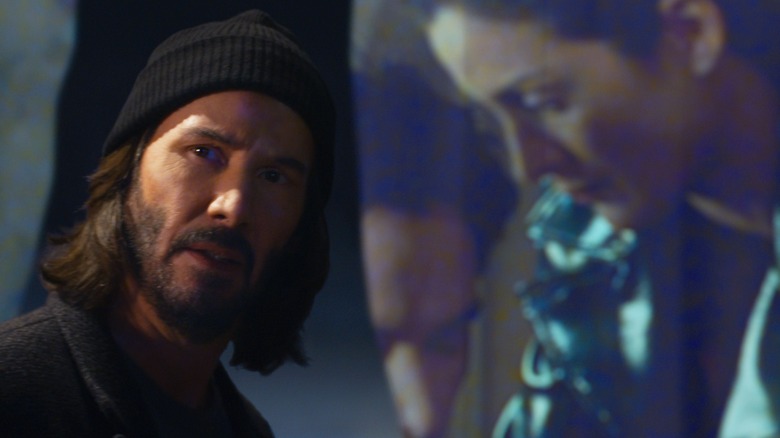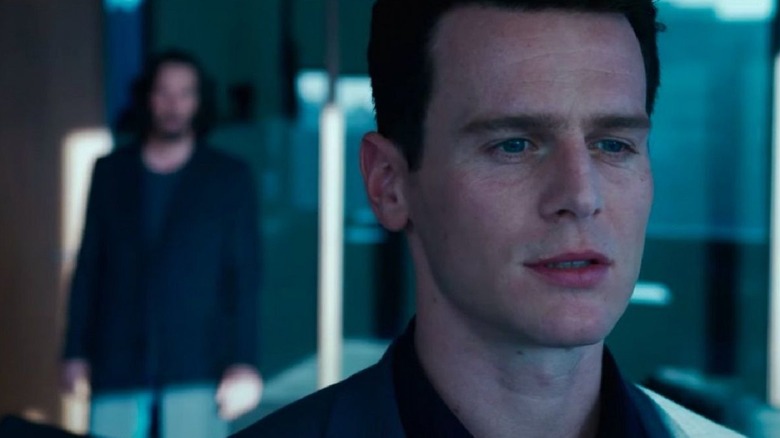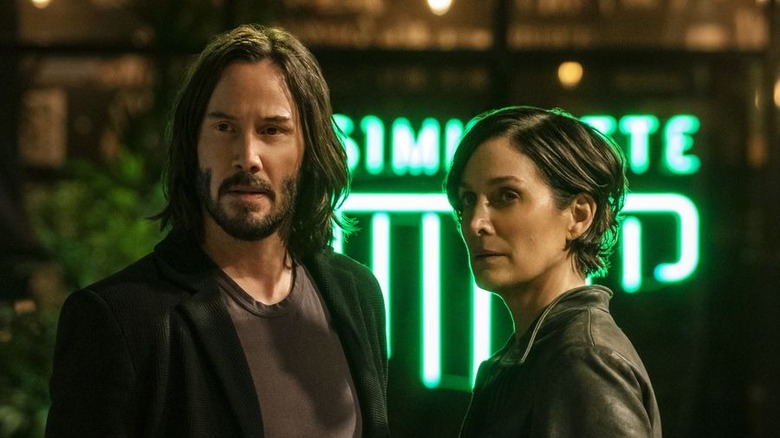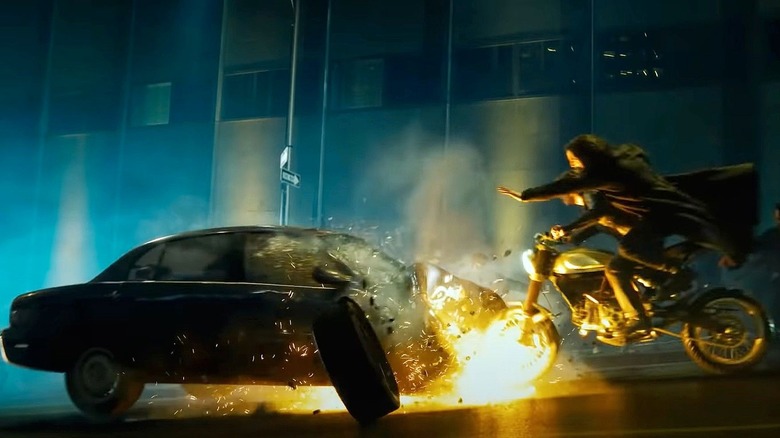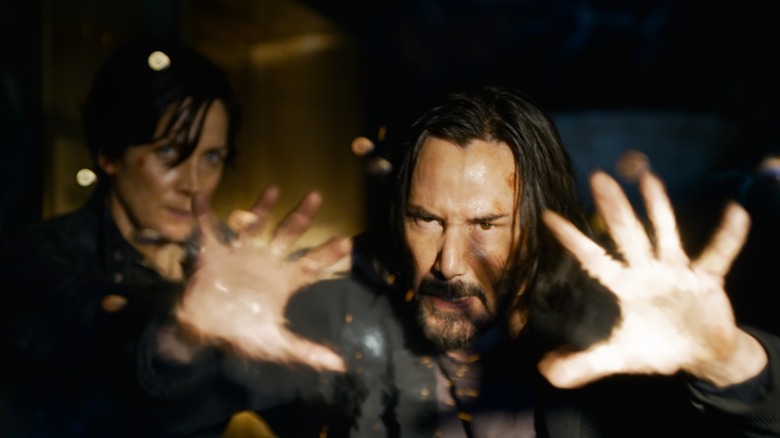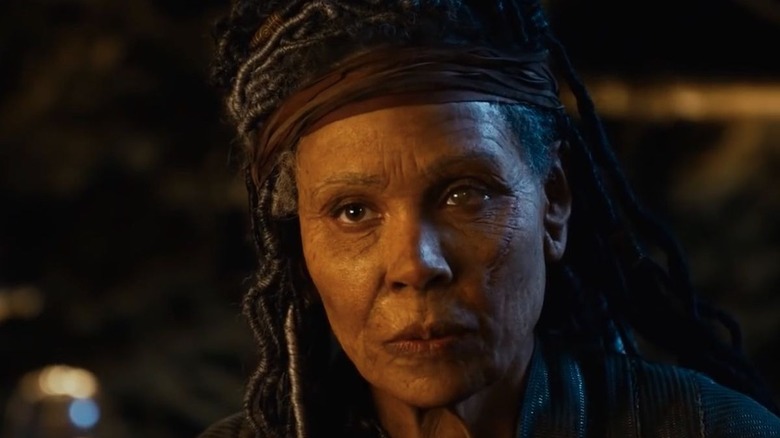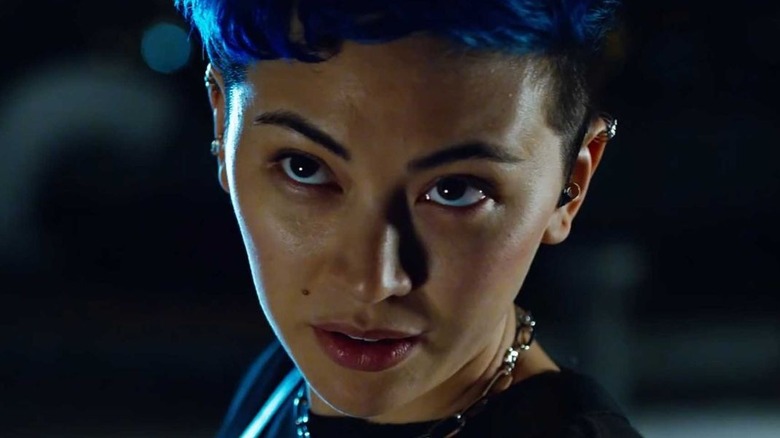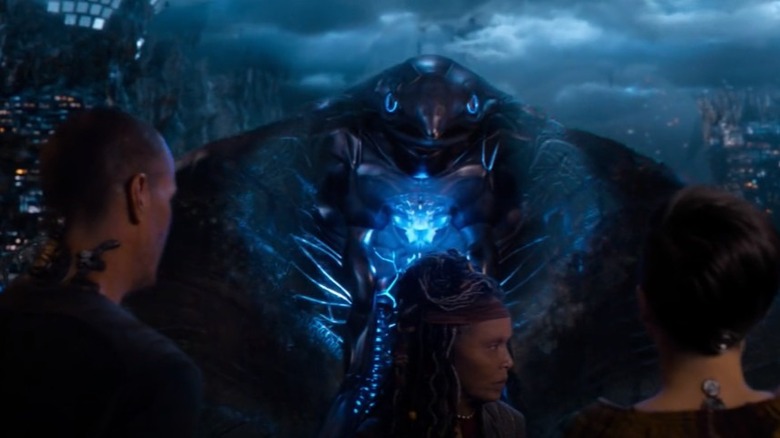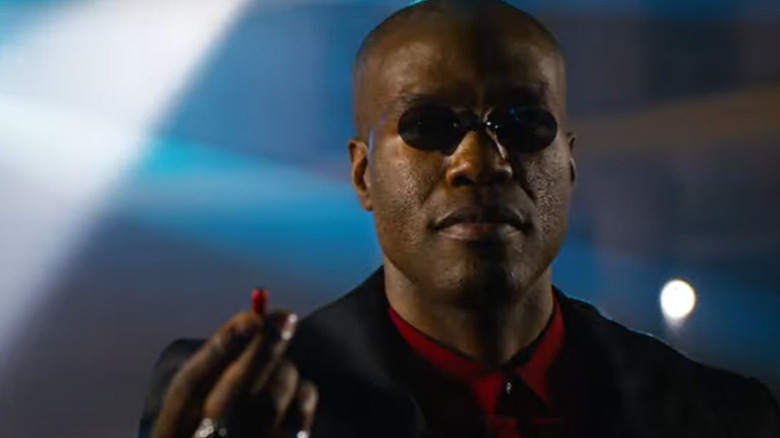The Six Best (And Worst) Things About The Matrix Resurrections
Warning: The following article contains spoilers for "The Matrix: Resurrections."
"Wes Craven's New Nightmare," the seventh installment of the "Nightmare on Elm Street" franchise, exists outside of the series' continuity and in a world in which Freddy Krueger is known for being ... an iconic movie villain. He plays himself in "New Nightmare" (as does Heather Langenkamp) because the plot concerns New Line Cinema bringing both Freddy and Nancy back, despite both characters being dead and despite both Langenkamp and Englund's lack of interest. Why make a new Freddy movie? Because Hollywood can't help itself. When there's money to be made, evil never dies.
While the first half of Lana Wachowski's "The Matrix Resurrections" seems explicitly in concert with the cynical meta cocktail "New Nightmare" mixed up 27 years ago, a later exchange it stages with Neil Patrick Harris' "The Analyst" reveals its even headier thesis: "[Humans] don't give a s*** about facts — it's all about fiction. The only world that matters is the one [in your heads]. And what validates and makes your fictions real? Feelings."
"The Matrix Resurrections," at its core, is a searing examination of how telling the same stories over and over is a balm for our hearts that thwarts their massive capacity. In 2021, the Matrix is convenience, is nostalgia, is whatever stokes our desires and fears in tandem. It is the opposite of "The Matrix Resurrections." Here are the six best (and worst) things about it.
Best: The Meta
As hinted at in the intro, "The Matrix Resurrections" has zero chill about breaking the fourth wall, making its audience uncomfortable, or letting its audience know that they're meant to be uncomfortable while watching a massive blockbuster. That discomfort goes full cringe during a creative brainstorming session at a video game company, where 1999's "The Matrix" is getting rebooted and a focus group-ready assemblage of pretentious, start-up castoffs wax egregiously about what it is while playing ping pong and downing lattes. This all culminates with Jude (Andrew Lewis Caldwell) grinning sadistically and moaning "Allow me to sum up our goal in a single word: bullet time." (Yes, it's two words. Doesn't matter.)
There are very few audiences who came to "The Matrix Resurrections" for this gradient of pitch-black cynicism, and the fact that it made it on screen in the middle of a sequel to one of the most successful and important movies ever made is nothing short of miraculous. Whether or not you agree with Wachowski's sentiment (or, indeed, if you feel attacked by it), there's no denying the truths it lays bare.
What's more: Blockbusters that challenge their audience even as they charm them can and should be a more regular fixture of the multiplex. The only way to change the systems which bind us is to challenge them from without and within. In "The Matrix Resurrections" case, the proverbial call is coming from inside Warner Bros' house. And that rules.
Worst: The Meta
If you've participated in what counts for "discourse" on social media this year, you've likely heard about "fan service" (defined here, and by this writer, as "material that's been added to a film for an audience's pleasure, usually not relevant to the story at large"). And for a minute there, the internet held "Spider-Man: No Way Home" and "The Matrix: Resurrections" in opposition to one another where "fan service" was concerned, on the basis of their trailers alone.
"Spider-Man: No Way Home" might as well have been "Fan Service: The Film." "The Matrix: Resurrections," refreshingly, looked the antidote to "blockbuster by-the-numbers" filmmaking. It had purpose, idiosyncrasy, and (often, it was implied) integrity. "The Matrix: Resurrections" has all those things. But its skewering of modern-day blockbusters is, at the end of the day, also fan service for a type of film fan who claims they abhor fan service.
The first act, in particular, mistakes angry window dressing for cinephile catharsis. There is zero reason, for example, to namecheck Warner Bros. studio. Here, it muddles the storytelling of what the new and improved Matrix is in favor of telling jaded moviegoers something they knew already — that the studio system sucks and reboots are the rage. Wachowski's anger is understandable and palpable. It also gets played on repeat in "Resurrections," to the film's detriment.
But, hey — that's fan service.
Best: It's A Genuinely Romantic Blockbuster
"The Matrix: Resurrections" becomes a heist movie in its third act, but Neo and his ragtag group of unplugged humans aren't trying to steal a multi-million dollar work of art or government-crippling hard drive. Instead, they're after true love. There are no words for how hard that rules, but I'll offer some, anyway.
Trinity and Neo have always been the heart of "The Matrix" films. What's more, their love has been a trilogy-wide counterbalance — to the series' ecstatic action, to its heady ideas, to its (frequently fun) pretensions. The orgy sequence in "The Matrix: Reloaded" made many uncomfortable; I call it "necessary" and "achingly sincere." Trinity and Neo, as a couple, were one of the things Trinity and Neo were always fighting for, not just because they love each other but because love is a power than can smash all systems, all binaries to pieces.
In "The Matrix Resurrections," that literally proves true. Without going too deep into spoilers (and I'm not sure I could explain it, anyways), the latest version of The Matrix has been constructed for Neo and Trinity. It hinges on both their closeness and their shared hopes. Wachowski lets us feel both equally. And when she lets their love be the reason an entire, enslaving construct is brought back to its knees, she reminds us what American film's been missing — a genuinely romantic action blockbuster. In "The Matrix Resurrections," we have one.
Worst: The Action
"The Matrix: Resurrections" didn't need to have better action sequences than the other "Matrix" films. They didn't even need to be on par with them. For one, what makes an exemplary action sequence can be a matter of taste; one man's trash is another man's treasure, after all. For another, topping the marriage of innovation and brutality that Yeun Woo-ping officiated across the original trilogy is an impossible ask for almost anyone, and "The Matrix Resurrections" has no less than Chad Stahelski of "The Matrix," "Birds of Prey," and "John Wick" fame stepping in for him. You can't say "The Matrix Resurrections" didn't arrive bearing bonafides aplenty.
So why is it listed under "Worst?" Because the one requirement of an action sequence in "The Matrix Resurrections," as explicitly stated by the film's plot, is to be in concert with the original "Matrix" films. Some fights are meant to mirror those of previous films in the franchise. Others deliberately zig where past battles zagged. The action is, enjoyably enough, integral to the storytelling. But "Resurrections" shows strain in its more blatant attempts to echo or channel the past. Shots are framed too closely for maximum effectiveness, and the skirmishes frequently approximate their origins more than channel them.
This isn't clear until the film's stellar final sequence, which breaks free from and casts aside multiple series hallmarks to find its own, singular butt-kicking voice. And speaking of that sequence...
Best: The Third Act
During the conclusion of the Wachowski Sisters' masterpiece "Speed Racer," Racer X reveals the film's real thesis, which is really the thesis for every Wachowski film that's ever existed: "It doesn't matter if racing changes. What matter is that we let racing change us." The systems which keep humanity and expression in check and make boxes of people's lives — be it the Matrix or the bureaucracy of a professional racing competition — can be shattered by the truths, which bring us joy and the things we're born to do. Racing changes us. That's what makes it beautiful.
This thesis reaches its equally stunning conclusion in the third act of "The Matrix: Resurrections," which throws gobs of anti-fascist imagery, a love heist, surprising character payoffs (Agent Smith?! Agent Smith!), and the film's best action sequence into a blender and lets the technicolor gloriously splatter all over the screen. There are so many gorgeous details to note and unpack, from Trinity and Neo not picking up a gun once during their whole race to freedom (really!), to the moments when "Resurrections" goes full zombie movie, to the stunningly shot sunrise building-leap which anchored the film's first trailers. It's a stretch of the film that may change even the most resistant audience members ... and they'll be the better for it.
Worst: The Second Act
I'm not sure anyone had "Priyanka Chopra and 'Jada Pinkett-Smith in old age makeup' get reduced to exposition machines" on their vision board for "The Matrix: Resurrections," but it's a sight that comes to unfortunate fruition in Lana Wachowski's film.
While there's some nifty world-building in the movie's second act, much of it is clumsily undercut by the multiple monologues about what happened after Neo passed that both actors are saddled with (It doesn't help that Pinkett-Smith is buried under layers of only mildly effective old age makeup). And that's made all the more frustrating because "Resurrections" goes out of its way to show and not tell us why Trinity and Neo's love matters. It offers the same courtesy to the Synthients, a race of sentinels that had a change of heart and now work with and not against humans.
Best: The Score
For those of a certain age, the original "Matrix" has an all-time great soundtrack album. Newly unfortunate Marylin Manson track aside, the record is a hodgepodge of every simultaneously revolutionary sound 1999 had to offer: You get vintage Deftones nu-metal, gorgeous and abrasive techno, and — to top it all off — an all timer from Rage Against The Machine. There's little more that one could ask for.
Yet "The Matrix" delivered "more," as well. Twenty two years after its release, the most overlooked part of the Wachowski Sisters' classic might be Don Davis score, which has quietly accrued a fairly large well of reverence. Beyond its iconic swell of horns and strings, Davis' work is full of propulsive percussion that builds atmosphere quicker than Mouse does bombshells. It's as important to that film's legacy (plus "Reloaded" and "Revolutions") as "bullet time."
Davis does not return to compose "The Matrix Resurrections," but new maestros Tom Twyker and Johnny Klimek do a superlative job of imbuing Davis' original cues with new blood. Familiar passages appear in unexpected places. The use of electronic and organic instruments frequently challenges the electronic-organic binary. And when it's time for the most romantic swell of notes to ever grace a "Matrix" movie, the duo are more than up to the challenge. Twyker and Kilmek have created music that rocks and rolls while honoring the scores and soundtracks which have come before it. It's an all-time great.
Worst: The Rage Against The Machine Cover
Look, on the list of musical artists who are difficult to cover successfully, Rage Against The Machine have to be number one. You're up against Zach de la Rocha's syntax. Someone has to do Tom Morello guitar things. Yet more people have to find the Death Star exhaust port-sized pocket Tim Commerford and Brad Wilk slipped into so often and so effortlessly while everyone else is attempting to channel the aural identities of those previously mentioned legends, keeping the fury of it all intact. It. Ain't. Easy.
So, my hat is off to Brass Against, who did a commendable job of attacking Rage's "Wake Up" in a clip that went viral three years ago. It's boisterous and angry, a good listen even if it never really becomes as transcendent as the original. That said, my hat stays on for whoever chose to use said cover at the end of "The Matrix Resurrections."
The film ends with Trinity and Neo flying off to change the world ("maybe paint the sky full of rainbows"), pointedly echoing the conclusion of the original "Matrix." As such, a needle drop of the same Rage song interpolated differently isn't a terrible idea. But Brass Against's cover is more imitation than new integrity, and fails to be a mirror for the ground-breaking thematic content which drives Wachowski's literal and metaphoric return to the franchise.
In other words, it's more like the newfound Matrix itself — a slick reboot. The intentions are good. The end product is lacking.
Worst: The Film's Mixed Messages About Therapy
I would like to offer the following caveat before this entry: Please go read Emily VanDerWerff's compelling, vulnerable, and very thoughtful analysis about how trauma is explored in "The Matrix: Resurrections." Not only because it's brilliant, but because Emily, unlike me, is a trans critic — and I, a cis white male, may not be the audience for what Lana Wachowski is attempting to unfurl therein in regards to societal and systemic relationships to trauma and the ways they keep those marginalized in check. I can admit to blind spots I might not even know I have before writing another word.
Emily very astutely observes that the film's big bad, the Analyst (Neil Patrick Harris), uses the language of modern therapy to keep Neo locked down. He calls Neo "triggered" every time he approaches the truth of his situation, and gently reminds him he's not crazy even while prescribing him "blue pills" that shackle his mind. But rather than be a strike against therapy, VanDerWerff writes that the movie's "use of trauma as a seemingly trendy buzzword [keeps it] in conversation with modern blockbuster culture. The Analyst's invocation of trauma isn't meant as a strike against the concept of trauma as one that blinds us to the true nature of reality. It's a strike against anyone who would use trauma as an all-purpose boogeyman. It's a strike against trauma as a cheap storytelling device."
I accept this interpretation in full. I also believe that Wachowski didn't do enough to make that come across clearly enough given the delicacy of the subject matter. There's a surface-level read of the therapy scenes in "Resurrections" which supports every toxic idea about the uselessness of therapy and the way that feelings are easily coddled. That read is made grosser by the reveal that the Analyst is the film's villain, and given even more credence through one, simple mistake: Ending the film with a beatdown of the Analyst in his office and in his original, proverbial sheep's clothing.
If Neo and Trinity can see people and bots in The Matrix for what they are, then they can see through the way The Analyst is presenting himself (To Wachowski's credit, the Analyst sheds his approachable, professional look when his true colors are revealed earlier in the movie). What's more, the beatdown could happen anywhere; there may be poetry to setting it in his now-wrecked home, but doing so is all but asking for a misinterpretation — particularly when the two and half hours prior haven't exactly courted subtlety.
To be clear: film doesn't need to be ethical. Film doesn't need to be moral. But in a country where mental illness is already stymied and audiences see what they want to see, ending your movie with two heroes unhinging a therapist-villain's jaw from his face so he can no longer speak is a dice roll that feels more sophomorically gleeful than carefully considered.
I look forward to finding out what my therapist thinks about all this.
Best: A Non-Binary Blockbuster
"The Matrix: Resurrections" isn't a non-binary blockbuster because it's directed by a woman whose existence challenges the binary notion that gender is assigned at birth. It's not a non-binary blockbuster because defeating the Matrix means cracking the binary systems which have represented the Matrix since the very beginning. No, "The Matrix Resurrections" understands that the fictions we tell ourselves can be as binary as the conformist ideals that fuel subjugation.
The sneaky danger of reboots or re-imaginings is that they're often little more than sleek regurgitation. Trips to the multiplex become an excuse to digest the same old code, and the lack of anything other than familiar IP becomes its own form of oppression. As the Analyst posits: "Desire and fear, baby" — the binary that keeps humans in check. A cynical read on the slate of what's available at an average American movie theater would suggest that audiences desire what they know and fear being challenged. Given the chaotic nature of life in 2021, that's somewhat understandable. It also has to change.
The world that matters most is the one inside our heads, what we allow ourselves to imagine. For two and a half hours, "The Matrix: Resurrections" allows us to imagine a different kind of Matrix film, which in turn is a different kind of blockbuster. It's not a totally new story, but it's not zeroes and ones, either. It's non-binary franchise filmmaking and, on that level alone, it's a triumph.
